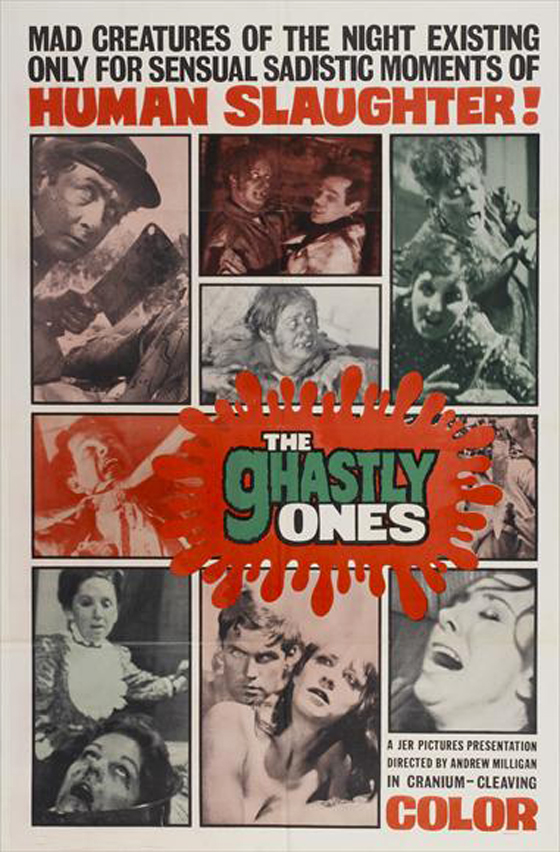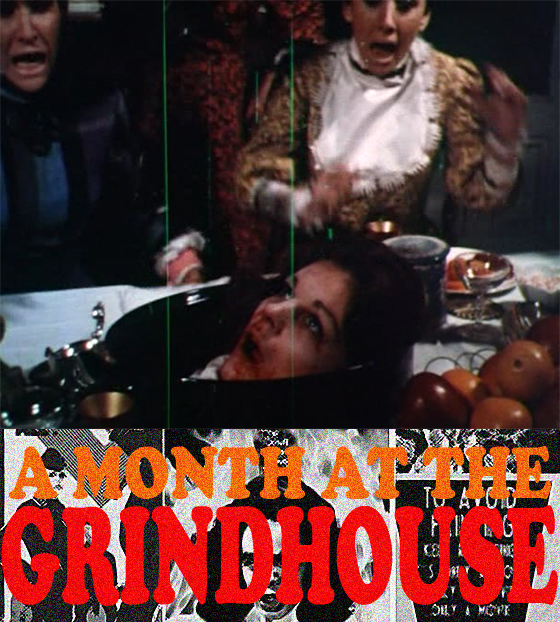
You have to set your expectations appropriately when you walk into an Andy Milligan picture. The Ghastly Ones (1968): what are we dealing with here? A movie shot on about $13,000 at his house on Staten Island with some friends and locals, some cheap gore effects, abundant use of library music, and, for the love of God, it’s a period picture with an ensemble cast and a murder-mystery plot. So what he achieves is not exactly Hammer or Amicus. It’s closer in spirit and style to the underground films of the Kuchar brothers. There’s a sensationalist, melodramatic zeal to how Milligan – a gay cruiser with an outlaw streak – sends up more respectable Victorian-themed horror movies, and how he inserts touches of sex, incest, homosexuality, S&M, and Herschell Gordon Lewis-style gore; he’s aiming his film at the New York grindhouse crowd, and the period trappings don’t trap anything – they just fall right over at the slightest nudge. By conventional standards, his film is poorly acted, haphazardly edited, and claustrophobically shot (Milligan’s primitive, 16mm sound-on-film Auricon swinging in so close to the actor’s cheeks that their faces become distorted, and you can practically see the camera’s shadow). The script is obvious and hilariously talky. Absolutely nothing convinces, except for the enthusiasm.
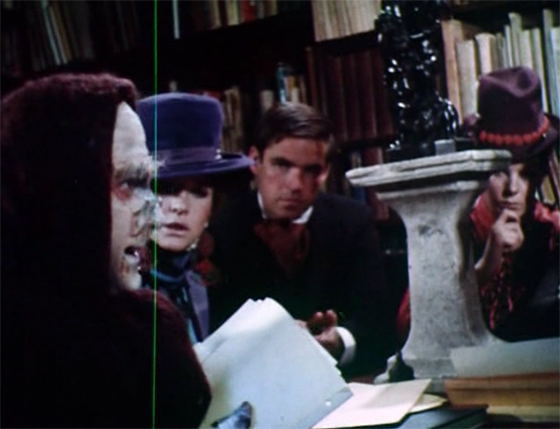
Neil Flanagan, in old hag makeup, reads out Papa's will to the Crenshaw clan.
The Cat and the Canary-style plot involves the Crenshaw family, whose father has just passed away, leaving riches (from “his vast holdings in South America”) to be distributed to his daughters Victoria (Anne Linden, The Filthy Five), Elizabeth (Carol Vogel, Depraved!), and Veronica (Eileen Hayes, Seeds). According to the will – which is read by Milligan regular Neil Flanagan (Guru, the Mad Monk) in some of the worst “old man” makeup you will ever see – the women are to take a boat out to Crenshaw Island, then wait at the secluded estate for three days before their reward is issued. Should anything go wrong in those three days – the lawyer is careful to note – then the inheritance will go to the eldest daughter, Victoria, to be divvied out as she sees fit. We know the island is a sinister place, because it’s the setting for a gruesome murder in the film’s pre-title sequence; although, as it turns out, that murder has nothing to do with the film’s plot, so you can disregard. Three servants attend the empty estate: sleepy-eyed Martha (Veronica Radburn, Kiss Me, Kiss Me, Kiss Me!), the older Hattie (Maggie Rogers, The Filthy Five), and Colin (Hal Borske, Vapors, The Naked Witch, The Filthy Five, etc.), who is a Lennie Small-type simpleton seen gleefully killing and gnawing on a cute rabbit. Soon Victoria and her husband Richard (Fib LaBlaque) find that rabbit in their bed, with a note attached stating, “Blessed Are the Meek, For They Shall Inherit.”
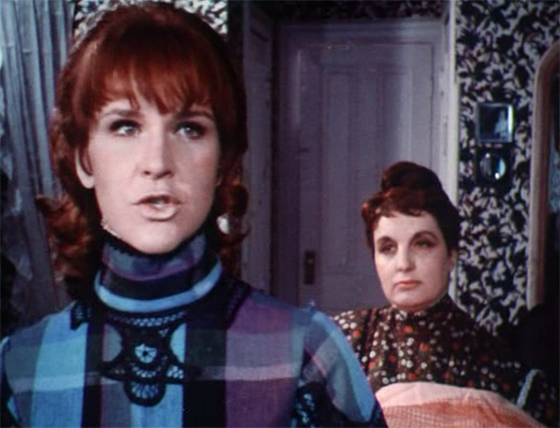
Victoria (Anne Linden) and Martha (Veronica Radburn).
After the film’s excruciating first half, filled with irrelevant character detail (if amusingly florid, such as the fact that Richard’s brother Walter continues to lust after him following some incestuous childhood incident), the narrative finally picks up at the Crenshaw House. A bloody X is left on the door of one couple’s room. Those who explore the basement are immediately slaughtered by a hooded figure. (After the cellar has made itself known as a place where people go to die, one of the husbands insists on exploring despite Martha’s warnings. As soon as he takes the first few steps, the hooded maniac swings in from behind and starts following; he doesn’t notice.) Colin, with his bad teeth and fragmented sentences, is at one point whipped by the otherwise sedate Martha just for accidentally dropping a chest he’s lugging downstairs. “PICK IT UP! PICK IT UP!” she howls as she flogs him. Late in the film Colin is accidentally set ablaze, a common fate to be endured by actor Hal Borske; in Bill Landis and Michelle Clifford’s 2002 book Sleazoid Express, Milligan is quoted as saying, “Hal was such a delight to set on fire.” Sex and nudity is scattered about at regular intervals, most of it unflattering as Milligan brings his camera in close on pale skin and all its blemishes. In the film’s most famous image, the severed head of one of the Crenshaw daughters makes a surprise appearance at the dinner table. A short interval later and Martha is comforting one of the distraught sisters in her room, telling her, “You must try to eat something. You haven’t eaten anything since you came.”
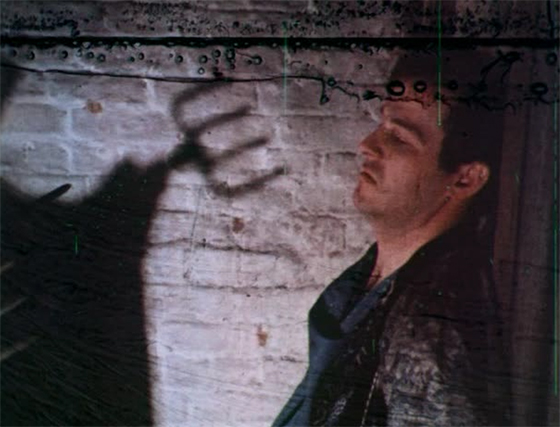
The hooded killer attacks William (Don Williams).
The Ghastly Ones was Milligan’s first color film, but it’s pretty drab nonetheless; the brightest color I found was the green of the vertical lines scratching up this beaten-up print. At times it really resembles a home movie shot at his house, which it pretty much was, adding an extra level of humor to shots such as the opening, in which two lovers in Victorian garb frolic by the water, the landscape cluttered with weeds and dead trees; this is probably the only spot he could find on the shore without modernity appearing on the horizon. In other shots, the background is entirely black, so poorly lit because close scrutiny would show the set’s anachronisms. (Those come through anyway, and in droves. In the early going I frequently wondered if this was truly meant to be a period picture.) The film’s weaknesses can be attributed to equal parts incompetence and poverty – Milligan makes do with what’s available to him, endearingly. It must also be said that although it’s not a parody, neither is it straight-faced. Milligan knew what he was making and who the audience was – he was aiming his mini-epics of glorious (and camp) trash at 42nd street theaters, every bit of outrageousness served up to a crowd that liked their movies wild and raw. The film was enough of a hit to send him on to films like Torture Dungeon (1970), Bloodthirsty Butchers (1970), The Body Beneath (1970), and The Rats are Coming! The Werewolves are Here! (1972). After contracting AIDS, Milligan died in 1991 in Los Angeles, leaving behind a vast body of work that continues to baffle the curious…
